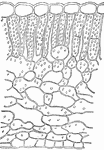Clipart tagged: ‘palisade’

An 11th Century Norman Castle, Aerial View
Illustration of an aerial view of an 11th century Norman castle in Europe. From this view, it is possible…

Section of Fortified Wall
"Section of Fortified Wall. (Interior on the left; exterior on the right.) a, a, is the abatis; b, b,…

Leaf Architecture
"Diagram to show the architecture of a typical leaf in the region of one of the lateral veins. The shaded…

Palisade
"Palisades should be planted to incline slightly to the front. As little earth should be disturbed in…

Rhododendron
This illustration shows a section of a leaf of Rhododendron. Note the compact palisade tissue which…

Spathyema
This illustration shows a section of the leaf of skunk cabbage, Spathyema. Note the poorly developed…